This week I took a day out from my home garden to take part in a garden tour of Chenies Manor in Buckinghamshire. It’s an exuberant garden bursting in late summer colour
I’ve focussed on writing here about some of the border plantings but there are many interesting features of this garden which make a visit there worthwhile – and I don’t just mean the teas. There’s a maze, physic garden and an ancient oak tree which is thought to have been a favourite place for a young Elizabeth I to play when she visited here.
The Chenies Manor Website gives details of garden tour and tea tickets and the available opening times during Covid-19 restrictions.
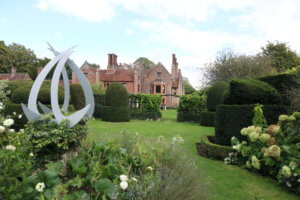
Colourful Dahlias in the Chenies Manor Sunken Garden
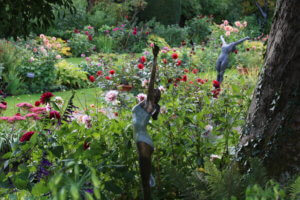
This garden shows how useful dahlias are for late summer colour and that when artfully curated, a dahlia display is hard to beat. I saw an interesting social media post recently which went along the following lines. “Remember when dahlias were out of fashion? Let’s go back there”. Now I’m a dahlia fan anyway but this garden showed me why consigning the dahlia to garden history would be a mistake.
The structure of this garden is undeniably attractive, with tiers of stone and grass paths descending towards a central statue and lily pond so it would be easy to think anything would look good here.
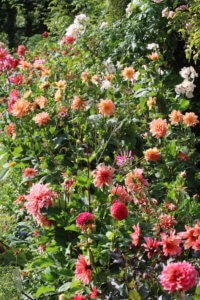
However, I imagined the view without the dahlias, erasing them in my head and trying to think of some other plants that could replace their colour and form to such charming effect so late in the season. I couldn’t think of any. Roses maybe, but somehow no.
Each spring, these borders are filled with a similarly exuberant group of flowers with a comparably extensive colour palette – tulips. It’s such a great example of how a well structured garden can be injected with superb colour for full impact displays twice a year.
This is of course a very labour intensive gardening technique – an autumn busy with dahlia clearance and tulip bulb planting, a spring busy with dahlia potting and cuttings and it’s a testament to the Head Gardener and her team of volunteers that in the year of the Covid-19 pandemic this garden looks so perfect.
A perfect white border
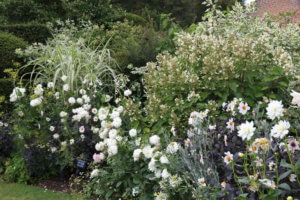
Dahlias can add an eyeful of colour but sometimes a tasteful tableau in white can have just as much impact – as shown in this superb border display. This border is part of a wider white-themed area of the garden.
The single dark leaved dahlia variety is called ‘Twynings After Eight’ and I think the larger waterlily type may be one called ‘Furka’. I really love the background shrub planting here, including the variegated Weigela but the stand-out plant has to be the variegated grass – probably Phalaris arundinacea ‘Picta’ – the Variegated Ribbon Grass. This border would be so much poorer without it.
A border to cheer the faceless facade of an epidemic panic

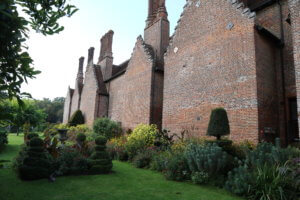
Chenies Manor house itself provides a beautiful backdrop to this superb garden. The mellow brickwork and famous Tudor chimneys give the garden gravitas.
Most striking is the multi-gabled facade of an entire wing with no windows. This Tudor extension was added during the time of an epidemic. London, just 20 miles to the south, was hit by the plague. The designers believed that the disease was borne in the air in a miasma fog so the London-facing walls were kept windowless as a first line of defence.
It is rumoured that each room in the wing had a privy, even in Tudor times and that these were emptied at ground level. The energy and vivaciousness of the plants at the base of these walls certainly would indicate a nutrient rich soil.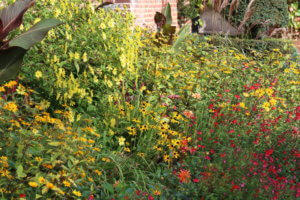
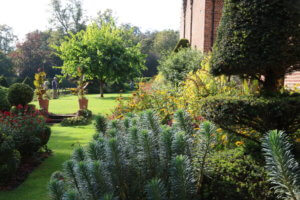
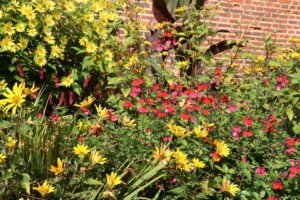
Cerise flowered- Salvia Royal Bumble amongst helianthus
These impressive walls now provide the backdrop for a blazing late summer border of helianthus, cannas, dahlias and persicaria. The predominant colour is yellow and boy is it a cheerful sight, but some magic touches of bright pink break up the golden glow and add depth to the planting scheme. Most notable was the pinky orange flowers of Salvia ‘Royal Bumble’ – a fantastic plant for autumn colour.
Garden sculptures
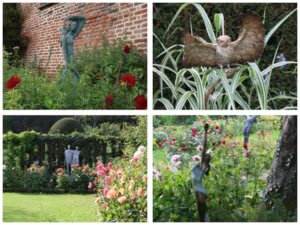
This garden is punctuated with many garden sculptures, some within the flower beds, others providing focal points to draw you through the garden’s main desire lines.

My absolute favourite is this image of a girl with a ram. Many plants and garden themes have links to the Greek Myths so I have chosen to interpret it as the golden fleeced ram from the Greek myth of Phrixus and Helle. Sentenced to death through the machinations of jealous step-mother Imo, the siblings’s birth mother, Nephthele sent the ram to save them. Helle fell off the flying ram and drowned in the sea but Phrixus made it to Colchis on the Black Sea coast. The heroic ram was sacrificed, its fleece giving rise to the quest of Jason and his argonauts.
Is this the golden ram with with Nephthele? Maybe it has a a different mythical origin entirely? I’m not sure but I do know that this is the most charming garden sculpture I have ever seen and it looks fabulous with a shady border backdrop.
Autumn Crocus – Colchicum autumnale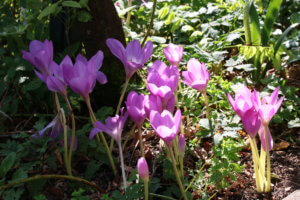
Phrixus arrived safely on the back of the ram in a place called Colchis, a part of ancient Greece on the Black Sea coast. I was delighted to see these drifts of Colchicum autumnale – the autumn flowering crocus, not just because they’re delightful but also because they are named after Colchis, the place.
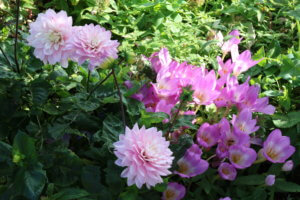
These are not related to crocuses although they do look like a crocus but are a bit larger. The long stems make the colchicums a bit unsteady on their pins and you sometimes see them collapsed on the ground. Yet, when fully upright with the sun shining through them they are simply wonderful to see – like shining amethyst jewels in the soil.
Asters in the vegetable garden.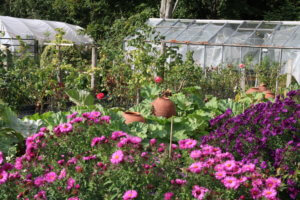
The vegetable garden at Chenies Manor is both productive and pretty. My eyes were drawn to a path edge lined with the knock your socks off colour of Michaelmas Daisies. I think these are the type that we used to call asters but are now known as symphyotrichum.
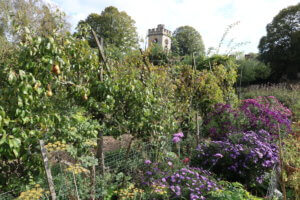
No autumn garden is complete without this wonderfully varied plant. It is a full colour pick-me up come rain or shine.
This seasonal diary is part of a weekly link-up of garden bloggers from around the world, called Six on Saturday. For more information and links to other blogs crammed with gardening activity, check the blog of host The Propagator.
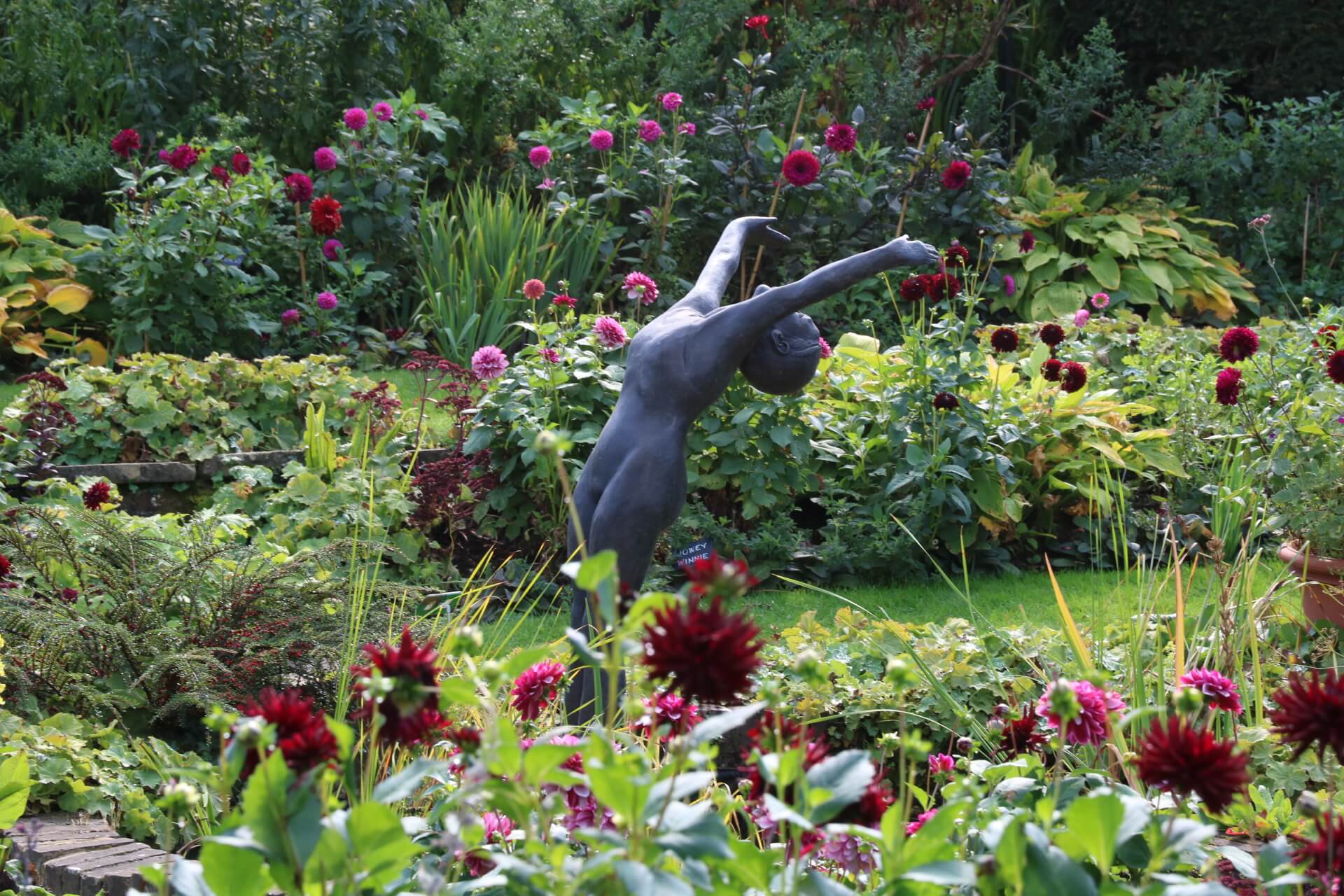
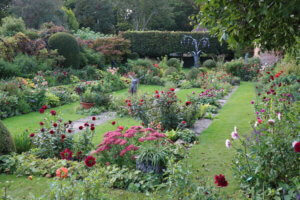

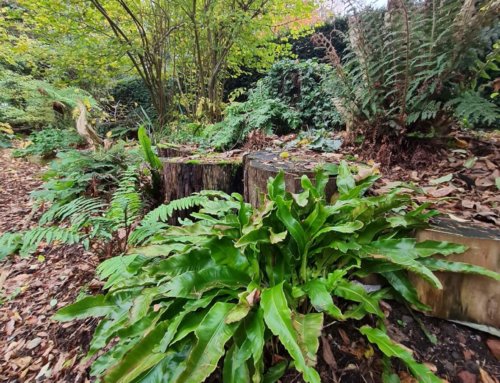
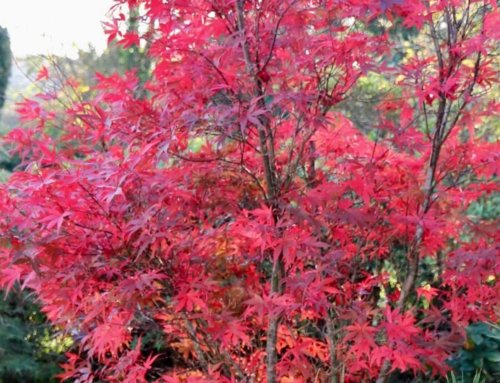
Beautiful photographs from your garden visit, there’s so much variety.
The dahlias in the garden make such an amazing display. I remember my dad used to grow them and then for a long time in more recent years the seemed to vanish. Nice to know that they’re back in fashion and hope they stay with us.
I’m using plunge pots this year and next to rotate dahlias and tulips. I have dahlias sunk into the border in 20 litre pots, they will be lifted out when the frosts arrive and be replaced with tulips, also in 20 litre pots. During the cold weather the tulips can be potted up in the greenhouse, then lifted to the vacant hole and dropped in. That’s the theory – it’s yet to be put to the test!
Hi Catherine, your sunken 20 litre pots idea sounds very clever. I’m really hoping it works out for you as it will really be a labour laving technique. I’ll look forward to seeing the results!
I presume dahlias went out of fashion because of trend for ‘low maintenance’ gardening, and they do require work, but they are worth it. I certainly look forward with anticipation to their flowering, and they stay in flower for a relatively long time. I loved reading about your garden visit. It looks like a lovely garden and hopefully I’ll go and see it for myself some time. Thanks also for identifying the grass in the white garden. It really does add something to that border and I might have just the place for it 😊
I know – the variegated grass really surprised me. Did you see the picture of the owl sculpture with the grass behind? It looks wonderful.
What a beautiful and interesting place to visit.
Hi Graeme, I had a wonderful time there. I’ve visited before for a plant fair and loved it. This year it’s even better through. Splendid planting.
Gorgeous flowerbeds with all these dahlias …and stunning sculptures ! You’re right the last one is also my favourite.
I also liked these asters : they have various sizes and colours.
Conclusion : I love this garden a lot. Thanks for sharing it.
Thanks Fred – whilst I love sharing pictures of my own garden and what I’m growing – visiting great gardens is always inspirational. There’s always something I see that I will take away and try at home. I’m glad you enjoyed reading about this garden over there in France.
Cracking article Katharine supported by some outstanding images. It was a beautiful afternoon and hopefully I will see you on the road again. Best wishes. Richard
Thanks Richard, we were lucky to visit weren’t we. See you in another garden I’m sure.
A beautiful garden.
It really is Paddy. Top drawer.
What an amazing place to visit. I love the sculptures dotted about.
Yes, I’ve never been a huge fan of garden sculptures but these all were perfectly chosen and perfectly placed.
March
(That’s odd –I thought I’d posted a comment) So very beautiful and your excellent descriptions have me feeling like I visited, Katharine. The ram and girl are wonderful, and I love the arms-lifted, rejoicing women as well.
Yes the rejoicing women were fantastic. I’m so glad you liked how I described the garden – it’s a challenge to portray a garden like this in words.
There’s nothing like having a new bit of garden to develop to make me look more closely at sets of pictures like these. The sunken garden gets the balance between the exuberant planting and its formal setting spot on, for me at least. A lovely garden.
Thanks Jim. I don’t get out and about enough to gardens and when I do I always come away inspired. So glad you liked it too.
wow that looks like a fab garden. i like the sculptures too. lovely write up, i am sure your garden forgives you the time away.
I’m not sure the garden does forgive me. I’m never really on top of things but I’ve learned to cope with that. As long as something’s flowering and looking good, I’m happy. Chenies Manor is a great garden to visit and when Covid allows they’ll probably restart the plant fairs which are great. Striking distance from Caversham maybe?
Thank you so much fo this lovely article on our gardens!
Our gardens really are a labour of love and hard work from our gardeners, staff and volunteers – and we are delighted to be able to share them with our visitors every season.
I was blown away with how good it’s looking and one of my friends read my article and came for tea and cake this week. She loved it too!